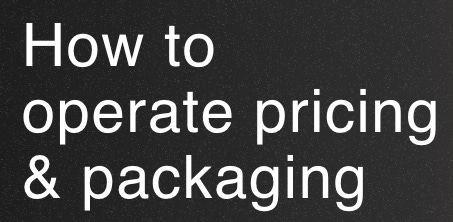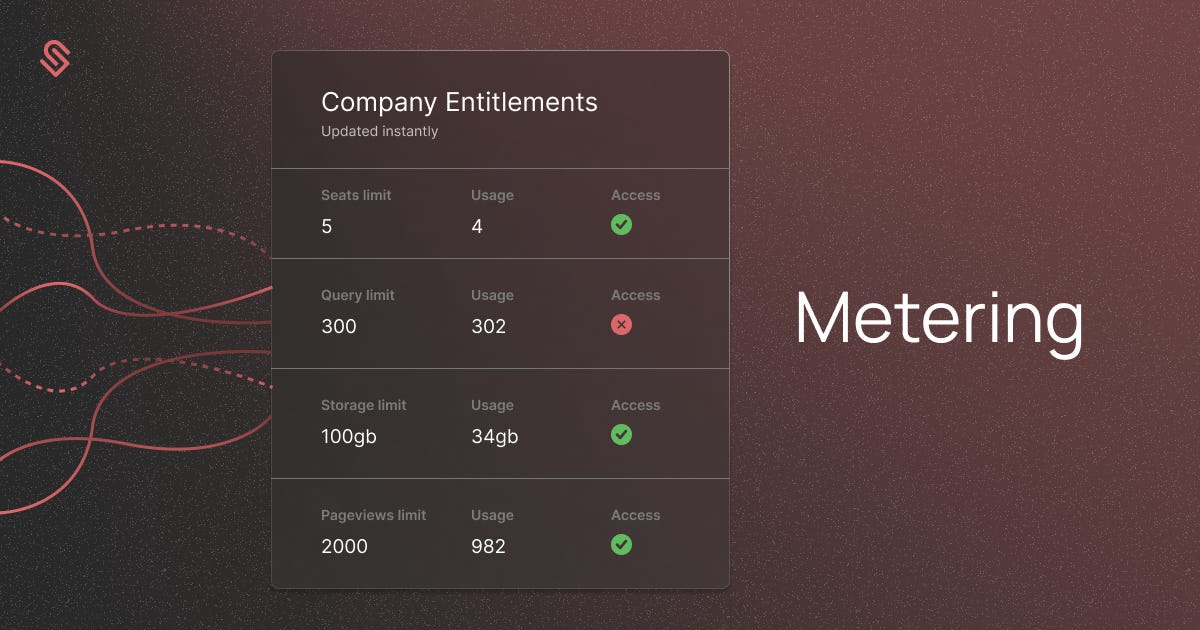How to operate pricing & packaging in B2B Software
A New Standard for Implementing & Operating Pricing & Packaging in SaaS
A truism in startups is that pricing & packaging will change.
Another truism is that product & engineering teams spend too much time re-inventing the wheel to support the inevitable iterations.
In this article, originally published on Schematic’s blog,
& I will propose a way to build pricing & packaging systems to maximize both control and flexibility. Our hope is that this article can be useful to company builders in 2 ways:Eliminate the need for businesses to reinvent the wheel when it comes to architecting the code & systems that govern pricing & packaging.
Enable businesses with a framework to achieve a balance between control and flexibility so that they can take advantage of opportunities for revenue acceleration.
Any collection of tools and processes must be responsive and flexible if pricing & packaging is to serve a company as a lever, rather than a bottleneck. Few companies effectively manage to build such a system.
As we have seen first hand and corroborated across hundreds of companies, homegrown systems for governing pricing & packaging end up costing companies millions of dollars per year as they reach scale. Homegrown systems also carry huge opportunity costs along the way, as engineering is constantly diverted to work on logic that isn’t new value, and the business is regularly delayed in releasing new monetization initiatives.
“We have delayed a pricing study for 2 years at Automox. We couldn’t action the study in the product even if we had it.”
Justin Talerico, CMO, Automox
Who is this written for & what are the takeaways?
Product & engineering leaders who are thinking about, or re-thinking their approach to managing pricing & packaging, as well as founders & CEOs who appreciate the growth that pricing & packaging can drive when controlled flexibly.
The takeaways will be threefold:
This article presents a method for flexible pricing & packaging management, as businesses grow and diversify their offerings.
It highlights the importance of decoupling pricing from application code.
It presents five components that, if implemented, yield control and flexibility over pricing & packaging.
“If I could wave a magic wand and build something new, I’d make it easier to change packaging without screwing up billing.”
Anthony Tyrpin, Sr. Engineer
Our Story
We’ve managed pricing & packaging across different venture-backed SaaS companies, from the first company we founded, to growth stage companies. Most recently, and prior to founding Schematic, we were tasked with owning pricing & packaging at a high growth SaaS company after their Series C.
At first, we were excited about the impact the work could have on the business. There could be millions of dollars in upside. Furthermore, we were supported by a full-stack growth team. Speed was our secret weapon. We could move faster, be more agile, iterate with more pace.
But after 12 months, we’d been able to affect only two changes (release of a new tier and lifted list price). The business was still not maximizing packaging to capitalize on all the new product value, as our original analysis had proposed, and there’d been very little experimentation or iteration subsequent to the new tier’s release and the price lifts.
Furthermore, the economy had changed, and the analysis that had earlier suggested higher prices could be absorbed by the market was proving to have mixed results. There had been a slight uplift in ARPU, but marketing sourced leads were converting less than they had before the changes. There was executive concern that the changes were scaring off potential prospects, and that we were out pricing the market.
The time between our initial analysis and our eventual implementation was so significant that by the time we’d released, the changes were already stale.
Everyone was frustrated.
Engineering was frustrated by having diverted 3 of our best engineers to work on billing systems.
Those engineers were equally frustrated, as they found the work tedious & stressful.
Product & Marketing were frustrated by the inability to be more responsive and iterative.
Finance & ops were battling SKU sprawl and underwater with the requests to confirm the customers’ access lined up with expectations.
Our story is a common source of frustration and unrealized value for B2B SaaS companies. It is a story that in its aggregate across thousands of companies, highlights a huge weight on innovation and growth for digital businesses.
We all talk about pricing & packaging as the great lever of growth that companies too often under-utilize. But what those statements usually don’t highlight is the underlying systems problem that makes it incredibly complex and expensive for operators across product, engineering, and ops to achieve control of & flexibility with their pricing & packaging.
“80-90% of our portfolio companies can’t implement our pricing or packaging recommendations due to technical constraints.”
Jorge Rosales, Pricing COE, Insight Venture Partners
How to operate pricing & packaging from Day 0 to IPO and beyond
There are 5 components that support a more flexible pricing & packaging system. Companies who operate pricing & packaging well will understand each of these systems in detail and their importance. Those components are:
The Product Catalog
Company Profiles
Metering
Subscriptions
Flags
Component 1: The Product Catalog
What it is
The Product Catalog is essentially a policy file that describes a company's products (sometimes called SKUs or plans) and associated entitlements. Products can describe platforms, tiers, or add-ons. The definition of a product should include default values for allocations or limits, and pricing.
The catalog should include all permutations of products offered to customers, including those that may no longer be actively sold. This can be referenced across systems to inform sales, marketing, support, and billing functions.
“We should think of the SaaS Product Catalog as a unified design environment, rather than a mere SKU registry. It’s the unifier of the SaaS ecosystem.”
Mircea Pana, Product, VMWare
Component 2: Company Profiles
What it is
The Company Profile is a centralized record for company state, aggregating all relevant company traits, subscription details, and usage data into a single, coherent profile.
The profile should be key-based and key uniqueness should be enforced across profiles to prevent duplicates. A company should be maintained with up-to-date context regardless of whether they are free, paid, or inactive accounts.
History should also be maintained for each profile to track changes.
“Lacking a unified customer view across channels leads to analytical hurdles, complicates revenue recognition, and burdens support with tier verification tasks, slowing down our operations significantly.”
Jack Roeder, FP&A, Retool
Component 3: Metering
What it is
Metering is usage tracking of features or services and is crucial for supporting usage-based models. Metered features can be monetized or un-monetized (tracked for telemetry or enforcing a packaged limit).
Usage tracking should support idempotency and include a company key, feature key, and datetime, forming the basis for billing and insights into company behavior. Usage can be processed as it occurs or batched periodically, depending on performance requirements.
“Usage-based pricing is here to stay, but not staying the same. The rise of generative AI and continued development of cloud infrastructure and SaaS pricing models will lead to even further innovation in hybrid and success-based pricing.”
James Wood, VP Product, M3ter
Component 4: Subscriptions
What it is
The Subscriptions component is essentially a relationship between a product in the Product Catalog and a Company Profile. It should describe information about the start and end time of the subscription, price, and allocations or limits.
A subscription is added on initial conversion, and new subscriptions can be added at any time. For example, for feature trials or to terminate an existing subscription. A company may have more than one active subscription, and subscriptions should never be deleted.
In aggregate, subscriptions should represent a historical record of change orders. Furthermore, it should enable GTM or Ops teams to answer questions about a customer’s bill, what products they have access to, and upcoming changes.
“SaaS companies should be able to define an offering and have it flow through to their tools (product, CRM, billing system, web/api presence: offering name, features available, usage quotas, rate limits, seats, price/billing info). It should be defined once and inherited across the application & business systems.”
Andrew Morris, Founder, GreyNoise,
Component 5: Flags
What it is
The Flags component manages who gets access to what features or services based on their context. This ensures customers can access only the features they should have access to, which is crucial for trials, tiered services, and premium offerings.
Company access is technically a flag check that occurs at the feature level, informed by the parameters of a company’s subscription and the product catalog. This check should never occur at the plan level so that plans can shift as the business changes.
Flags should be granted permissively, so if entitlements for a given company are conflicting, the more permissive one is granted depending on the level they are granted.
“The tight coupling of how we represent “what we give to customers”, or entitlements, and how we bill customers for those plans & entitlements have led to a pricing & packaging scheme that is costly to change over time.”
Ed Blankenship, Product, Contentful
Conclusion
The main purpose of this article is to propose a new architectural standard for managing pricing & packaging in digital businesses. We hope it’s useful, and it was informed by conversations with dozens of founders & engineering, ops, and product leaders, whose insights have been invaluable.
We’re grateful for several key pieces that have influenced our perspectives. Notable among these are:
The 14 pains of building your own billing system by Arnon Shimoni
Price Ops by Tier
The Hard Count: To Bill is to Build a Distributed System by Hunter Blanks
We gave a presentation on all of the above with Monevate recently:







